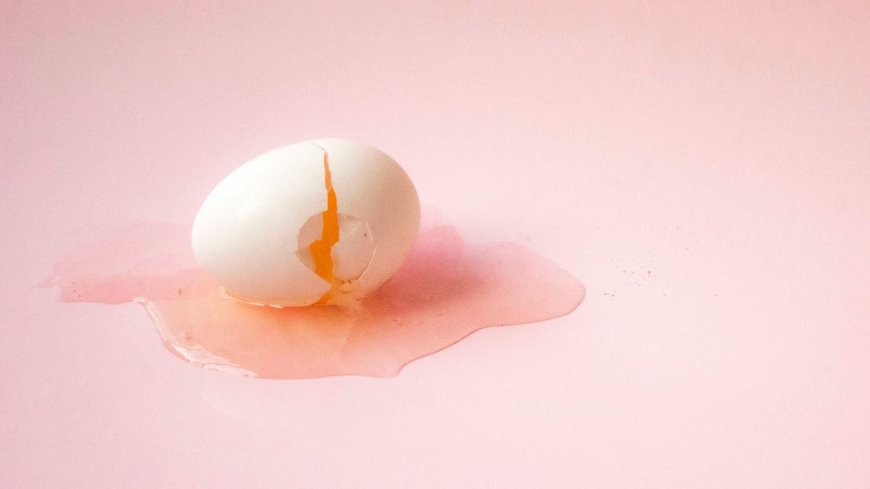Eggs less likely to crack when dropped on their side, according to science

Eggs Less Likely to Crack When Dropped on Their Side, According to Science
Written by Priya Sharma
Introduction: The Heartbreak of a Dropped Egg
We've all been there. That slow-motion moment when a slippery egg escapes our grasp, heading inevitably towards the kitchen floor. The resulting crack and messy cleanup are a familiar, minor tragedy in households worldwide. For decades, it seemed like any drop doomed the delicate shell. But what if the way an egg falls actually matters? Recent scientific insights suggest that the orientation of the egg during its fall significantly influences its chances of survival, offering a fascinating glimpse into the physics of this everyday object.
It turns out, dropping an egg isn't purely a matter of luck. Science indicates that an egg landing on its side, along its equator, is considerably less likely to fracture compared to landing on either of its pointed ends. This counterintuitive finding challenges our assumptions and highlights the remarkable structural design inherent in nature.
Unpacking the Science: Why the Side is Safer
The secret lies in the egg's unique shape and the principles of physics governing stress distribution. An eggshell, primarily composed of calcium carbonate, is a marvel of natural engineering. Its curved, ovoid shape isn't just for biological function; it provides surprising structural integrity.
Think about architectural structures like arches or domes. These shapes are incredibly strong because they distribute weight and stress evenly along their curves, preventing force from concentrating at a single point. An eggshell functions similarly. When an egg lands on its side, the impact force is spread over a larger, more gently curved surface area. This distribution lessens the stress at any specific point on the shell, increasing its resistance to cracking.
Conversely, the pointed ends of an egg represent areas of much higher curvature. When an egg lands on one of these points, the impact force is concentrated onto a very small area. This concentrated stress easily exceeds the material strength of the calcium carbonate shell at that point, leading to the fracture we commonly see. It’s similar to how pressing down with the flat of your hand distributes pressure, while pressing with a fingertip concentrates it intensely.
Studies examining eggshell strength often involve controlled drop tests or compression tests, meticulously measuring the force required to fracture shells at different points. These experiments consistently show that the shell can withstand significantly more force when applied perpendicular to its long axis (on the side) compared to force applied along the axis (at the ends). The physics of eggs and their impact resistance demonstrate nature's efficient design.
Asarkari's Take: More Than Just Breakfast Science
At Asarkari, we find this exploration into egg cracking physics particularly intriguing because it underscores how much complex science is hidden in plain sight, even in our refrigerators. This isn't just a quirky fact; it touches upon fundamental principles in materials science, engineering, and biology.
The eggshell's design is a testament to evolutionary optimization – creating a structure strong enough to protect the developing chick, yet weak enough for the chick to break out of. Understanding how this structure handles stress has implications beyond the kitchen. Engineers constantly study natural structures like eggshells, seashells, and bamboo to inspire designs for stronger, lighter materials and protective casings. The way an egg distributes impact force could inform the design of everything from helmets to vehicle crumple zones and protective packaging for delicate goods.
Furthermore, it serves as a simple, tangible example of stress concentration – a critical concept in preventing structural failure in bridges, buildings, and aircraft. The weak points aren't always intuitive, and understanding where stress concentrates allows engineers to reinforce designs appropriately. The humble egg provides a readily available, if fragile, case study.
Practical Implications and the Limits of Science
So, should you deliberately try to drop your eggs on their side? Probably not! While science suggests the side is *more* resistant, an eggshell is still inherently fragile. A fall from a significant height onto a hard surface is likely to cause a crack regardless of orientation. Careful handling remains the best strategy for preventing cracked eggs.
However, this knowledge does provide a fascinating insight. It explains why sometimes, miraculously, a dropped egg survives the fall – it might have just landed luckily on its side. It also subtly influences how eggs are often packaged, nestled securely to minimize point impacts during transport.
The study of why eggs break easily is linked to fracture mechanics, analyzing how cracks initiate and propagate in brittle materials like calcium carbonate. The microscopic structure of the shell, including pores and crystal alignment, also plays a role in its overall strength and how it fails under stress.
Conclusion: Appreciating the Egg's Engineering
The finding that eggs are less likely to crack when dropped on their side is more than just trivia; it’s a window into the elegant physics governing natural structures. The egg's ovoid shape is a masterful solution for distributing stress, making the shell surprisingly resilient when force is applied correctly – along its broader curve.
While we should all continue to handle eggs with care, understanding the science behind their structural integrity adds a layer of appreciation for this everyday food item. It’s a reminder that sophisticated engineering principles are embedded all around us, often in the most unexpected places. So, the next time you handle an egg, take a moment to appreciate its clever design – a product of millions of years of evolution and a teacher of basic physics.
kam sabdo me kahein to: Scientific studies suggest an egg dropped on its side has a better chance of surviving the fall compared to being dropped on its pointed ends due to better force distribution along its curve.
For more interesting science facts, job updates, and sarkari news, visit https://asarkari.com.
Signed off, Team Asarkari
Keywords
egg drop science, egg cracking physics, how to drop an egg without breaking, eggshell strength, egg drop experiment, egg structure, why eggs break easily, preventing cracked eggs, egg science facts, egg impact resistance, physics of eggs, eggshell structure, stress distribution in eggsWhat's Your Reaction?
 Like
0
Like
0
 Dislike
0
Dislike
0
 Love
0
Love
0
 Funny
0
Funny
0
 Angry
0
Angry
0
 Sad
0
Sad
0
 Wow
0
Wow
0










































